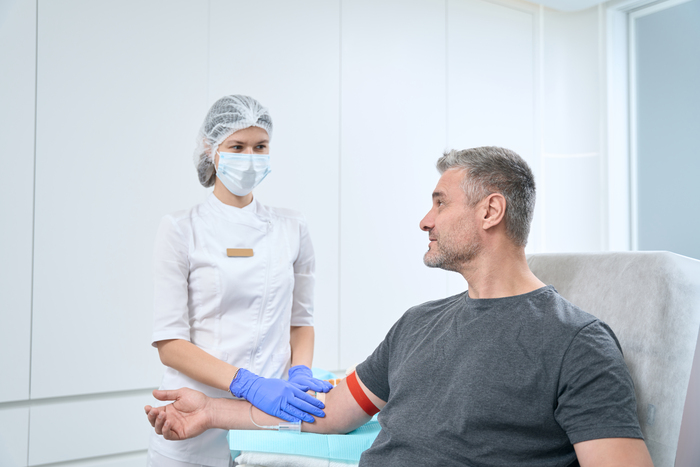
Ensure your health. Get tested today.
Convenient lab testing at your fingertips at more than 5,000 locations nationally. Consult with a doctor, or get tested on your own.

The ELISA test, or Enzyme-Linked Immunosorbent Assay, is a laboratory technique used to detect and quantify specific proteins, such as antibodies or antigens, in a sample. Research shows that the test operates on the principle of antigen-antibody interactions, utilizing the specificity of antibodies to bind to target molecules.
Coating the Plate: The process begins with a microplate that is coated with a specific antigen or antibody, depending on the target of the assay.
Sample Addition: A sample containing the target molecule (e.g., serum, plasma, or other biological fluids) is added to the wells of the plate. If the target is present, it will bind to the coated surface.
Binding of Detection Antibody: After washing away unbound substances, a secondary antibody that is linked to an enzyme is added. This antibody specifically binds to the target molecule, forming a complex.
Substrate Addition: Following another washing step to remove excess secondary antibody, a substrate for the enzyme is introduced. The enzyme catalyzes a reaction that converts the substrate into a detectable signal, often producing a color change.
Measurement: The intensity of the signal, which correlates with the amount of target molecule present in the sample, is measured using a spectrophotometer or similar device.
This straightforward yet effective approach makes ELISA a widely used method in diagnostics, research, and various applications across the biomedical field.
ELISA is a versatile diagnostic tool used to detect a variety of diseases, according to current research — including:
Ebola Virus Disease
COVID-19 (SARS-CoV-2)
Zika Virus Infection
Hepatitis B and C
Dengue Fever
Syphilis
Tuberculosis (TB)
Rheumatoid Arthritis (through detection of specific antibodies)
Brucellosis
Some types of allergies
These applications highlight the importance of ELISA in both clinical diagnostics and public health monitoring.
There are different types of ELISA tests, each used for different purposes:
This method is used primarily to detect antibodies in a sample. The target antigen is immobilized on the plate, and the sample is added. If antibodies are present, they will bind to the antigen. A secondary enzyme-linked antibody that recognizes the bound antibodies is then added, followed by a substrate that produces a detectable signal. This type is commonly used for serological testing.
This format is designed to detect and quantify antigens. It involves two antibodies: a capture antibody that is coated on the plate to bind the target antigen, and a detection antibody that is linked to an enzyme. After the sample is added and the target antigen binds to the capture antibody, the detection antibody is introduced, creating a "sandwich" of antibody-antigen-antibody. This method is highly sensitive and specific, making it suitable for measuring various biomarkers.
In this type, the sample antigen competes with a labeled antigen for binding to a specific antibody. The plate is coated with the antibody, and both the sample and the labeled antigen are added. The more antigen present in the sample, the less labeled antigen will bind to the antibody. The signal is inversely proportional to the concentration of the target antigen, allowing for quantification.
This type of ELISA is designed to measure the concentration of an analyte in a sample. It often employs a standard curve created using known concentrations of the target antigen, allowing for accurate quantification of unknown samples based on their signal intensity.
This format provides an estimate of the concentration of an analyte rather than an exact measurement. It is often used in screening applications where precise quantification is not necessary but relative comparisons are useful.
Similar to the standard sandwich ELISA, this method utilizes two different antibodies to capture and detect the target antigen. It enhances specificity and sensitivity, making it suitable for complex samples.
These various types of ELISA tests cater to different needs in diagnostics and research, allowing for flexibility in detecting and quantifying a wide range of biological molecules.
While the ELISA test itself is generally safe and poses minimal risks, according to current research, there are some potential risks associated with the sample collection process, according to the National Heart, Lung, and Blood Institute — particularly if blood is drawn. Here are some possible risks:
Dizziness: Some individuals may experience lightheadedness or dizziness during or after blood collection, especially if they are anxious or have not eaten prior to the test.
Fainting: In rare cases, individuals may faint during the blood draw due to anxiety, pain, or a sudden drop in blood pressure.
Bruising: It is common to develop a bruise at the site where the blood is drawn. This occurs due to the rupture of small blood vessels during the needle insertion.
Infection: Although the risk is low, there is a potential for infection at the site of the blood draw if proper sterile techniques are not followed.
Pain or Discomfort: Some individuals may experience pain or discomfort during the needle insertion or while the blood is being drawn.
Hematoma Formation: In some cases, blood can accumulate under the skin, leading to a hematoma, which may cause swelling and discomfort at the site.
While these risks are generally minor and manageable, it is important for healthcare providers to follow proper procedures to minimize them during the ELISA testing process.
Preparing for an ELISA test typically does not require any special preparations or restrictions, according to current publications. Patients can generally continue with their normal activities and diet before the test. However, it's always a good practice to follow any specific instructions provided by the healthcare provider or laboratory conducting the test.
In most cases, the test can be performed without fasting or altering medication regimens, but if there are any specific concerns or requirements related to the particular test being conducted, those should be discussed with the healthcare professional. Overall, the simplicity of preparation makes the ELISA test accessible and convenient for patients.
If you’re considering ELISA testing and want a convenient and reliable option, look no further than SolvHealth. With a user-friendly platform, SolvHealth makes it easy to find a lab near you that offers ELISA testing. You can compare local facilities, read reviews, and check availability, ensuring you receive the care you need without unnecessary hassle.
ELISA is used to detect and quantify specific proteins, hormones, antibodies, and antigens, aiding in the diagnosis of various diseases.
ELISA operates on antigen-antibody interactions, with a sequence of steps including coating the plate, sample addition, binding of detection antibody, substrate addition, and measurement.
Diseases such as HIV, Ebola, COVID-19, Hepatitis B and C, Zika Virus Infection, and others can be diagnosed using ELISA.
The ELISA test itself is safe, but there can be minor risks associated with the sample collection process such as dizziness, fainting, bruising, infection, pain or discomfort, and hematoma formation.
Yes, there are six types of ELISA tests, each serving different purposes. These include Indirect ELISA, Sandwich ELISA, Competitive ELISA, Quantitative ELISA, Semi-Quantitative ELISA, and Double Antibody Sandwich ELISA.
No, an ELISA test typically does not require any special preparations or restrictions.
Yes, in addition to clinical diagnostics, ELISA is a crucial tool used in research and quality control across multiple industries.
Yes, ELISA can detect some types of allergies, in addition to a wide range of diseases.

Convenient lab testing at your fingertips at more than 5,000 locations nationally. Consult with a doctor, or get tested on your own.